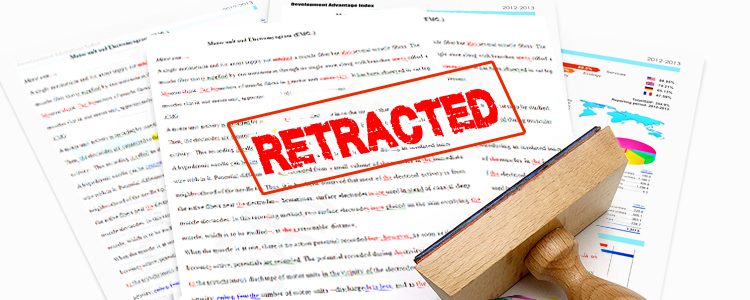Retractions Due to Image Manipulation by ESL Authors

There are multiple cases of article retractions due to duplicated or manipulated article images which have occurred recently in Life Sciences. These described cases involved researchers from China and Malaysia. One case concerned a research group at the University of Malaya, in Kuala Lumpur, Malaysia which involved researchers Nina Samie (first author) and Sekaran Muniandy (corresponding author). One figure that they produced appeared both in a Science Reports paper and in a Frontiers Pharmacology article. The first article was published in January 2016 and while it is still readable online, it bears a simple “Retraction (22 June 2016)” advisory in its header. The second one, from April 2016, is also still online and bears the same retraction advisory.
Researchers Jianting Miao and Wei Zhang, from the Fourth Military Medical University in Shaanxi, China, were both involved in repeated frauds over recent years. Manipulated images were detected in some of their publications about cognitive science and neurodegeneration. This led to the retraction of four papers, which were published in four different journals. Miao denied any willful manipulation and rather put the blame on the lack of experience of one author. One of the papers involved was published in Neuropeptides in 2008 and received 37 citations. Another paper was published in Neurobiology of Aging in 2012 and reached a total of 20 citations before retraction.
Further, recent frauds have involved two Chinese principal investigators, one based in China (Shandong University, China), the other working jointly in China and Canada (You Ann Hospital, Beijing, China and McGill University, Canada). Both articles were published in the journal Biochimica et Biophysica Acta – General Subjects. The two of them aimed at evaluating the anti-cancer properties of a gum resin compound of the ayurvedic plant Boswellia serrata. The article is now retracted with a note stating “This article has been retracted at the request of the authors. It contained multiple inaccurate and inappropriately processed Western Blots. (…)”.
Another proven misconduct involved researchers affiliated with the Beijing Key Laboratory of Crop Genetic Improvement, in Beijing, China. One of the first authors confirmed and apologized for his “low-level mistake” in manipulating some of the images using Photoshop.
Human Error or Misconduct
Mostly, when enquired about misconduct in figures that appeared in their articles, researchers will argue that a “mistake” may have happened, or that there has been some “confusion” between files. This was the case in the neurodegeneration studies of Miao and Zhang. Such mistakes indeed do occur, but they should normally be discovered the moment an article is revised by its authors and submitted to a journal.
However, in other cases, deliberate manipulation is undeniable. In the case which involved researchers from the University of Malaya, the same image appeared in different studies. In one case the image was said to correspond to liver cells, while in another one, to colon cells. Moreover, some parts of the image appeared to be clearly manipulated, with some sub-areas reproduced multiple times to generate a larger image. Therefore, in this case, the fraud is obvious and deliberate.
Reactions of the Scientific Community
Reactions of Peers
In a majority of cases involving image fraud, it is not the journals themselves that discover them, but readers that alert the journals. Scientists, therefore, need reliable knowledge in order to design their own experiments as having false results in the literature may lead them to erroneous principles and deductions. This can result in loss of research time and money.
Reactions of Journals
Journals generally take quick actions once they have been alerted by readers. The COPE guidelines are a general reference for defining scientific frauds. The first step in the case of suspicious images or data is for journals to contact the authors and have their opinion regarding the case. In some instances, authors admit the fraud; while in others, they claim that they were “mistakes”. Irrespective of the answer of the authors, whether erroneous or deliberately manipulated the article is retracted. However, procedures of retraction can vary across journals: some remove the article content from their website and mention the article as being “retracted”. Others may leave the full article online, inserting a retraction note in its header. This latter behavior can be misleading since this information remains searchable and fully viewable on the journal’s website.
Frequency of Misconduct
A systematical search for manipulated images was recently carried out by three researchers from diverse institutions. Elisabeth M. Bik, Arturo Casadevall, and Ferric Fang analyzed images from over 20000 scientific papers published over the period 1995-2014. The main criterion for deciding whether an image corresponded to an actual experiment or to a manipulated image was that all three co-authors had to separately identify some awkwardness in the image. The overall rate of “problematic” images identified by these authors was 3.8 %. Note that this study only addresses frauds on images, and searching for further types of data across publications might have resulted in a higher, hence more problematic, figure.
One critical piece of information concerning this study regards its own publication. The authors had faced three rejections of their paper. After this, they chose to publish it on the open access preprint database bioRxiv. It was then finally published in mBio, an open access journal of the American Society for Microbiology, in June 2016.
Do you know any other cases of retraction due to image manipulation? Please share your thoughts in the comments section below.









